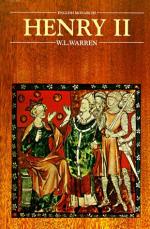The court became too a great school of history. From the reign of Alfred to the end of the Wars of the Roses there is but one break in the contemporary records of our history, a break which came in the years that followed the outbreak of feudal lawlessness. In 1143 William of Malmesbury and Orderic ceased writing; in 1151 the historians who had carried on the task of Florence of Worcester also ceased; three years later the Saxon Chronicle itself came to an end, and in 1155 Henry of Huntingdon finished his work. From 1154 to 1170 we have, in fact, no contemporary chronicle. In the historical schools of the north compilers had laboured at Hexham, at Durham, and in the Yorkshire monasteries to draw together valuable chronicles founded on the work of Baeda; but in 1153 the historians of Hexham closed their work, and those of Durham in 1161. Only the monks of Melrose still carried on their chronicle as far as 1169. The great tradition, however, was once more worthily taken up by the men of Henry’s court, kindled by the king’s intellectual activity. A series of chronicles appeared in a few years, which are unparalleled in Europe at the time. At the head of the court historians stood the treasurer, Richard Fitz Neal, the author of the Dialogus, who in 1172 began a learned work in three columns, treating of the ecclesiastical, political, and miscellaneous history of England in his time—a work which some scholars say is included in the Gesta Henrici II that was once connected with the name of Benedict of Peterborough. The king’s clerk and justiciar, Roger of Hoveden, must have been collecting materials for the famous Chronicle which he began very soon after Henry’s death, when he gathered up and completed the work of the Durham historians. Gervase of Tilbury, marshal of the kingdom of Arles, well known in every great town of Italy and Sicily, afterwards the writer of Otia Imperialia for the Emperor Otto IV., wrote a book of anecdotes, now lost, for the younger King Henry. Gerald of Wales, a busy courtier, and later a chaplain of the king, was the brilliant historian of the Irish conquest and the mighty deeds of his cousins, the Fitz Geralds and Fitz Stephens. “In process of time when the work was completed, not willing to hide his candle under a bushel, but to place it on a candlestick that it might give light to all, he resolved to read it publicly at Oxford, where the most learned and famous English clergy were at that time to be found. And as there were three distinctions or divisions in the work, and as each division occupied a day, the reading lasted three successive days. On the first day he received and entertained at his lodgings all the poor of the town, on the next day all the doctors of the different faculties and such of their pupils as were of fame and note, on the third day the rest of the scholars with the milites, townsmen, and many burgesses. It was a costly and noble act; the authentic and ancient times of poesy were thus in some measure renewed, and neither present nor past time can furnish any record of such a solemnity having ever taken place in England.”




